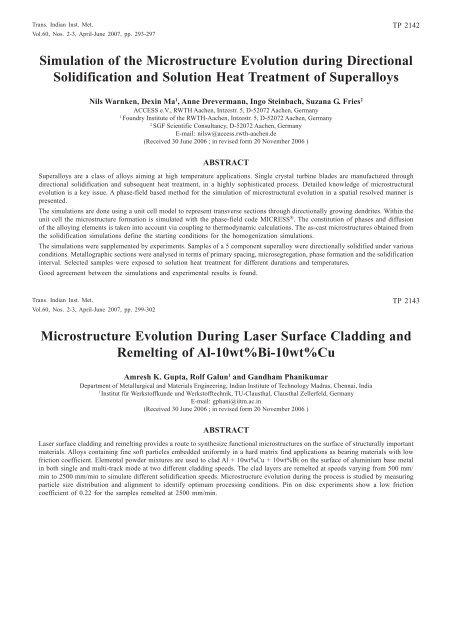Vol.60, Nos. 2-3 - Indira Gandhi Centre for Atomic Research
Vol.60, Nos. 2-3 - Indira Gandhi Centre for Atomic Research
Vol.60, Nos. 2-3 - Indira Gandhi Centre for Atomic Research
You also want an ePaper? Increase the reach of your titles
YUMPU automatically turns print PDFs into web optimized ePapers that Google loves.
Trans. Indian Inst. Met.<br />
<strong>Vol.60</strong>, <strong>Nos</strong>. 2-3, April-June 2007, pp. 293-297<br />
TP 2142<br />
Simulation of the Microstructure Evolution during Directional<br />
Solidification and Solution Heat Treatment of Superalloys<br />
Nils Warnken, Dexin Ma 1 , Anne Drevermann, Ingo Steinbach, Suzana G. Fries 2<br />
ACCESS e.V., RWTH Aachen, Intzestr. 5, D-52072 Aachen, Germany<br />
1<br />
Foundry Institute of the RWTH-Aachen, Intzestr. 5, D-52072 Aachen, Germany<br />
2<br />
SGF Scientific Consultancy, D-52072 Aachen, Germany<br />
E-mail: nilsw@access.rwth-aachen.de<br />
(Received 30 June 2006 ; in revised <strong>for</strong>m 20 November 2006 )<br />
ABSTRACT<br />
Superalloys are a class of alloys aiming at high temperature applications. Single crystal turbine blades are manufactured through<br />
directional solidification and subsequent heat treatment, in a highly sophisticated process. Detailed knowledge of microstructural<br />
evolution is a key issue. A phase-field based method <strong>for</strong> the simulation of microstructural evolution in a spatial resolved manner is<br />
presented.<br />
The simulations are done using a unit cell model to represent transverse sections through directionally growing dendrites. Within the<br />
unit cell the microstructure <strong>for</strong>mation is simulated with the phase-field code MICRESS ® . The constitution of phases and diffusion<br />
of the alloying elements is taken into account via coupling to thermodynamic calculations. The as-cast microstructures obtained from<br />
the solidification simulations define the starting conditions <strong>for</strong> the homogenization simulations.<br />
The simulations were supplemented by experiments. Samples of a 5 component superalloy were directionally solidified under various<br />
conditions. Metallographic sections were analysed in terms of primary spacing, microsegregation, phase <strong>for</strong>mation and the solidification<br />
interval. Selected samples were exposed to solution heat treatment <strong>for</strong> different durations and temperatures.<br />
Good agreement between the simulations and experimental results is found.<br />
Trans. Indian Inst. Met.<br />
<strong>Vol.60</strong>, <strong>Nos</strong>. 2-3, April-June 2007, pp. 299-302<br />
TP 2143<br />
Microstructure Evolution During Laser Surface Cladding and<br />
Remelting of Al-10wt%Bi-10wt%Cu<br />
Amresh K. Gupta, Rolf Galun 1 and Gandham Phanikumar<br />
Department of Metallurgical and Materials Engineering, Indian Institute of Technology Madras, Chennai, India<br />
1<br />
Institut für Werkstoffkunde und Werkstofftechnik, TU-Clausthal, Clausthal Zellerfeld, Germany<br />
E-mail: gphani@iitm.ac.in<br />
(Received 30 June 2006 ; in revised <strong>for</strong>m 20 November 2006 )<br />
ABSTRACT<br />
Laser surface cladding and remelting provides a route to synthesize functional microstructures on the surface of structurally important<br />
materials. Alloys containing fine soft particles embedded uni<strong>for</strong>mly in a hard matrix find applications as bearing materials with low<br />
friction coefficient. Elemental powder mixtures are used to clad Al + 10wt%Cu + 10wt%Bi on the surface of aluminium base metal<br />
in both single and multi-track mode at two different cladding speeds. The clad layers are remelted at speeds varying from 500 mm/<br />
min to 2500 mm/min to simulate different solidification speeds. Microstructure evolution during the process is studied by measuring<br />
particle size distribution and alignment to identify optimum processing conditions. Pin on disc experiments show a low friction<br />
coefficient of 0.22 <strong>for</strong> the samples remelted at 2500 mm/min.
















